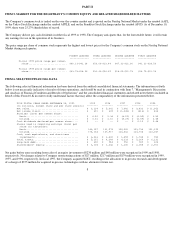Apple 1999 Annual Report Download - page 19
Download and view the complete annual report
Please find page 19 of the 1999 Apple annual report below. You can navigate through the pages in the report by either clicking on the pages listed below, or by using the keyword search tool below to find specific information within the annual report.GAINS FROM SALES OF INVESTMENT
As of September 26, 1997, the Company owned 42.3% of the outstanding stock of ARM Holdings plc (ARM), a privately held company in the
United Kingdom involved in the design of high performance microprocessors and related technology. The Company had accounted for this
investment using the equity method through September 25, 1998. On April 17, 1998, ARM completed an initial public offering of its stock on
the London Stock Exchange and the NASDAQ National Market. The Company sold 18.9% of its shares in the offering for a gain before
foreign taxes of approximately $24 million, which was recognized as other income. Foreign tax recognized on this gain was approximately $7
million.
At the time an equity method investee sells existing or newly issued common stock to unrelated parties in excess of its book value, the equity
method requires the net book value of the investment be adjusted to reflect the investor's share of the change in the investee's shareholders'
equity resulting from the sale. It is the Company's policy to record an adjustment reflecting its share of the change in the investee's
shareholders' equity resulting from such a sale as a gain or loss in other income. Consequently, the Company also recognized in the third
quarter of 1998 other income of approximately $16 million to reflect its remaining 25.9% ownership interest in the increased net book value of
ARM following its initial public offering. As of September 25, 1998, the carrying value of the Company's investment in ARM carried in other
assets in the consolidated balance sheet was approximately $22 million. On October 14, 1998, the Company sold 11.6 million shares (split
adjusted) of ARM stock. As a result of this sale, the Company's ownership interest in ARM fell to 19.7%. Consequently, beginning in the first
quarter of fiscal 1999, the Company ceased accounting for its remaining investment in ARM using the equity method and categorized its
remaining shares as available-for-sale requiring the shares be carried at fair value, with unrealized gains and losses net of taxes reported as a
component of accumulated other comprehensive income.
During fiscal 1999, the Company sold approximately 32.6 million shares (split adjusted) of ARM stock for net proceeds of approximately $245
million, recorded a gain before taxes of approximately $230 million, and recognized related income tax of approximately $25 million. As of
September 25, 1999, the Company's remaining 16 million shares of ARM stock are valued at $226 million. The fair value of the Company's
investment in ARM is reflected in other assets as of September 25, 1999, with an offsetting amount net of $84 million of related deferred
income taxes recognized in accumulated other comprehensive income.
PROVISION (BENEFIT) FOR INCOME TAXES
As of September 25, 1999, the Company had deferred tax assets arising from deductible temporary differences, tax losses, and tax credits of
$613 million before being offset against certain deferred tax liabilities for presentation on the Company's balance sheet. A substantial portion of
this asset is realizable based on the ability to offset existing deferred tax liabilities. As of September 25, 1999, a valuation allowance of $60
million was recorded against the deferred tax asset for the benefits of tax losses that may not be realized. The valuation allowance relates to the
operating loss carryforwards acquired from NeXT and to tax benefits in certain foreign jurisdictions. The Company will continue to evaluate
the realizability of the deferred tax assets quarterly by assessing the need for and amount of the valuation allowance. The Company's effective
tax rate for fiscal 1999 was 11% compared to the higher statutory rate due primarily to the reversal of a portion of the previously established
valuation allowance and certain undistributed foreign earnings for which no U.S. taxes were provided.
The Internal Revenue Service (IRS) has proposed federal income tax deficiencies for the years 1984 through 1991, and the Company has made
certain prepayments thereon. The Company contested the proposed deficiencies by filing petitions with the United States Tax Court, and most
of the issues in dispute have now been resolved. On June 30, 1997, the IRS proposed income tax adjustments for the years 1992 through 1994.
Although most of the issues for these years have been resolved, certain issues still remain in dispute and are being contested by the Company.
Management believes adequate provision has been made for any adjustments that may result from tax examinations.
16
























